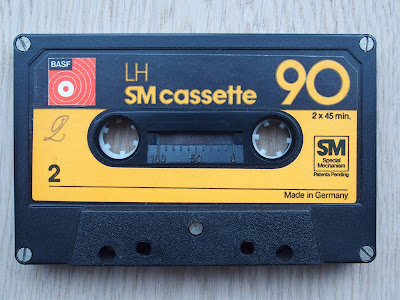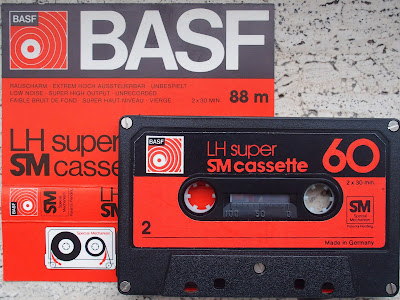This continues my evaluation of old cassette tapes, using my Nakamichi BX-300E
deck and Audiotester software. This time a bunch of BASF ferrics. You can find the equivalents from Maxell here, and from TDK here. And then there is of course the brand-new Recording The Masters Fox ferric.
For details on the measurement method look here.
Maxell UR (1994) (what the deck was calibrated for)
Relative bias: (reference)Relative sensitivity: (reference)
THD @ Dolby level: 0.42%
MOL400(THD=1%): +3.4dB
MOL400(THD=3%): +5.3dB
MOL1k(THD=3%): +2.9dB
SOL10k: -1.3dB
Bias noise: -49.5dB, -52.5dB(A)
Dynamic range: 57.8dB
Concerning sensitivity at 400Hz this UR seems a close match for the 1981 and 1994 IEC I references. At 10kHz UR sits between the old and the new reference.
BASF LH (1971)
Relative bias: -5Relative sensitivity: -2.1dB
THD @ Dolby level: 5.5%
MOL400(THD=1%): -6.0dB
MOL400(THD=3%): -2.0dB
Bias noise: -49.2dB, -52.0dB(A)
Dynamic range: 50.0dB
I am curious, orange.
This is my oldest cassette. It predates IEC standardisation by almost a decade. It was a small miracle that it cooperated with the BX-300. It was visually in good shape, but the tape made such scary grinding noises that I aborted the test before 1kHz and 10kHz output levels could be measured.
Noise is fine, but MOLs are horrible, justifying the later arrival of the so-called 'High Output' class of tapes. Despite the high distortion the zero-dB curve is not bad at all.
I also have a 1972 LH Olympia. It could no longer be recorded on, suffering a massive 40dB of signal loss. Curiously, increasing the bias to type II levels also increased the recorded signal, but never to normal levels...
BASF LH SM (1976)
Relative bias: -4
Relative sensitivity: -1.9dB
THD @ Dolby level: 4.7%
MOL400(THD=1%): -5.8dB
MOL400(THD=3%): -1.8dB
MOL1k(3%): -2.2dB
SOL10k: -4.7dB
Bias noise: -50.0dB, -53.0dB(A)
Dynamic range: 51.2dB
I was lucky with this sample. I also tested another two of these, plus the 1977 variant (looking similar but orange on top and black below). Even at minimal bias none of them could record any treble, and midrange sensitivity was a low -4dB.
BASF LH Super SM (1976)
Relative bias: -3Relative sensitivity: +0.4dB
THD @ Dolby level: 0.63%
MOL400(THD=1%): +1.4dB
MOL400(THD=3%): +3.7dB
MOL1k(3%): +2.8dB
SOL10k: -2.3dB
Bias noise: -48.8dB, -52.1dB(A)
Dynamic range: 55.8dB
By virtue of its lower noise a bit better than Maxell UD 1977, and clearly bettering LH SM. This cassette appeared in good condition, without chatter during winding. However, during the 0dB sweep the tape began to whine, forcing me to omit the +6dB sweep.
BASF Ferro Super LH (1978)
Relative bias: -3.5Relative sensitivity: +1.4dB
THD @ Dolby level: 0.73%
MOL400(THD=1%): +2.1dB
MOL400(THD=3%): +5.0dB
MOL1k(3%): +1.8dB
SOL10k: -1.0dB
Bias noise: -48.5dB, -51.7dB(A)
Dynamic range: 56.7dB
BASF Ferro Super LH-I / R723DG (1979)
This model was traded alongside Ferro Super LH, specifically aimed at Japanese decks operating at a higher bias level. I have one such sample, but despite the tape looking fine it proved incapable of holding any treble, and this at any bias level, so no measurements are provided here.Allegedly Ferro Super LH-I is the actual tape type used in batch R723DG, adopted in October 1979 as the first IEC Type I primary reference tape.
IEC Type I Primary Reference BASF R723DG datasheet.
BASF LH Extra I (1981)
Relative bias: -3Relative sensitivity: +0.1dB
THD @ Dolby level: 1.1%
MOL400(THD=1%): -0.5dB
MOL400(THD=3%): +2.6dB
MOL1k(3%): +1.8dB
SOL10k: -2.2dB
Bias noise: -48.3dB, -51.4dB(A)
Dynamic range: 54.0dB
BASF LH Super I (1982)
Relative bias: -3Relative sensitivity: +1.2dB
THD @ Dolby level: 0.65%
MOL400(THD=1%): +1.4dB
MOL400(THD=3%): +4.1dB
MOL1k(3%): +2.6dB
SOL10k:(no stable measurement)
Bias noise: -49.3dB, -52.1dB(A)
Dynamic range: 56.2dB
This cassette appeared to be in decent shape, yet the tape was so badly deteriorated that it was impossible to make acceptable frequency curves. Performance-wise it was a step above LH Extra I.
BASF LH Extra I (1983)
Relative bias: -0.5Relative sensitivity: +0.2dB
THD @ Dolby level: 0.52%
MOL400(THD=1%): +2.9dB
MOL400(THD=3%): +6.0dB
MOL1k(3%): +1.8dB
SOL10k: -1.3dB
Bias noise: -47.3dB, -50.6dB(A)
Dynamic range: 56.6B
Hi-Fi Choice's 1983 tape test says "... it seems to be only just IEC I compatible, for it requires about 1dB less bias for optimum results than IEC 1 reference". What we do know for sure, interpolating from the measurements below, is that the 400Hz sensitivity of this LH-E I indeed is virtually identical to R723DG's. 400Hz sensitivity is also identical to reference tape Y348M, which replaced R723DG in 1994 and had a 1.8dB higher response at 10kHz.
BASF LH (1984)
Relative bias: -1.5Relative sensitivity: +0.1dB
THD @ Dolby level: 0.65%
MOL400(THD=1%): +1.4dB
MOL400(THD=3%): +4.1dB
MOL1k(3%): +2.8dB
SOL10k: -1.6dB
Bias noise: -48.9dB, -52.0dB(A)
Dynamic range: 56.2dB
This was a budget tape, restricted to some markets. While its performance here betters many other BASF cassettes, this is not necessarily representative: allegedly these low-cost types were loaded with whatever tape was at hand.
BASF LH-E I (1985)
Relative bias: -1Relative sensitivity: +0.6dB
THD @ Dolby level: 0.50%
MOL400(THD=1%): +3.1dB
MOL400(THD=3%): +5.9dB
MOL1k(3%): +2.1dB
SOL10k: -1.4dB
Bias noise: -48.3dB, -51.4dB(A)
Dynamic range: 57.3dB
This was used, but in excellent shape. MOL and dynamic range are vastly better than the 1981 version. Curiously, the bias noise is exactly the same ...
BASF Ferro Extra I (1988)
Relative bias: -1Relative sensitivity: +0.4dB
THD @ Dolby level: 0.50%
MOL400(THD=1%): +2.9dB
MOL400(THD=3%): +5.9dB
MOL1k(3%): +3.2dB
SOL10k: -1.1dB
Bias noise: -47.7dB, -50.8dB(A)
Dynamic range: 56.7dB
This tape's 400Hz sensitivity allegedly slightly exceeds IEC I R723DG and Y348M. However, the 10kHz sensitivity is +1.2dB relative to R723DG, and -0.6dB relative to Y348M. So FEI is in-between the two IEC standards. This said, I tried three samples of differing history, and there was quite some variation.
BASF Ferro Extra I (1991)
Relative bias: -1Relative sensitivity: +0.4dB
THD @ Dolby level: 0.48%
MOL400(THD=1%): +2.6dB
MOL400(THD=3%): +5.4dB
MOL1k(3%): +4.6dB
SOL10k: -1.6dB
Bias noise: -47.9dB, -50.8dB(A)
Dynamic range: 56.2dB
BASF Ferro Extra I (1995)
Relative bias: -0.5
Relative sensitivity: +0.2dB
THD @ Dolby level: 0.43%
MOL400(THD=1%): +2.5dB
MOL400(THD=3%): +5.1dB
MOL1k(3%): +3.9dB
SOL10k: -1.3dB
Bias noise: -48.5dB, -51.6dB(A)
Dynamic range: 56.7dB
This cassette was new, sealed. Despite this side A gave serious problems
with treble roll-off in the left channel and unbalanced distortion. Side
B fared much better.
Emtec Ferro Extra I (2004?)
Relative bias: +1Relative sensitivity: +0.2dB
THD @ Dolby level: 0.17%
MOL400(THD=1%): +2.5dB
MOL400(THD=3%): +4.9dB
MOL1k(3%): +4.5dB
SOL10k: -1.4dB
Bias noise: -47.2dB, -50.2dB(A)
Dynamic range: 55.1dB
Allegedly made by Maxell-licensee PT Panggung in Indonesia. The date is not certain, as the cassette's lot code did not follow the established BASF/Emtec pattern. Very low distortion at Dolby flux.
BASF (Emtec) Sound I (1998)
Relative bias: +0.5Relative sensitivity: 0dB
THD @ Dolby level: 0.22%
MOL400(THD=1%): +2.9dB
MOL400(THD=3%): +5.0dB
MOL1k(3%): +2.7dB
SOL10k: -1.3dB
Bias noise: -47.5dB, -50.6dB(A)
Dynamic range: 55.6dB
Fine MOLs, and a remarkably low distortion at Dolby level. Sadly fairly high noise.
This tape is supposed to be on-target with the two IEC references at 400Hz, and at 10kHz 1.1dB high compared to R723DG, and 0.7dB low compared to Y348M.
BASF Ferro Maxima I (1988)
Relative bias: +5Relative sensitivity: +0.2dB
THD @ Dolby level: 0.68%
MOL400(THD=1%): +3.2dB
MOL400(THD=3%): +7.0dB
MOL1k(3%): +2.2dB
SOL10k: -0.2dB
Bias noise: -49.1dB, -52.5dB(A)
Dynamic range: 59.5dB
This is the only BASF superferric I have. It is bright, so on a fixed-eq recorder it needs a lot of bias, just like some versions of TDK AD and Maxell UDI. MOL at 400Hz is phenomenal, which makes the low MOL at 1kHz all the more disappointing.
BASF IEC I Primary Reference Y384M (1994)
Relative bias: +3Relative sensitivity: +0.4dB
THD @ Dolby level: 0.43%
MOL400(THD=1%): +3.5dB
MOL400(THD=3%): +6.7dB
MOL1k(3%): +4.0dB
SOL10k: -1.0dB
Bias noise: -48.0dB, -51.5dB(A)
Dynamic range: 58.2dB
End of 2021 I finally could lay hands on two genuine Primary Reference tapes, the 1994 type I Y384M and the 1987 type II U564W. These come from pancakes originally owned by a Philips production facility. The current owner, HPR, offers sections of these tapes loaded into NOS TEAC or BASF shells.
Three things jump out of the measurement results: 1) this is a very competent entry level tape. 2) it does not match any BASF Fe-I listed above, so it seems BASF made a one-off for IEC. 3) compared to the average compatibility parameters of all type I cassettes I tested it is quite a way off, even in sensitivity. I always questioned the need for a new reference as late as 1994, when cassette was already showing signs of decline. A deviating reference like this would have caused new decks to be overbiased for the majority of entry level ferrics on the market at that time. A strange decision. Maybe they were assuming that cassette had a long life left...
IEC Type I Primary Reference BASF Y384M datasheet.
INDEX OF ALL CASSETTES




































